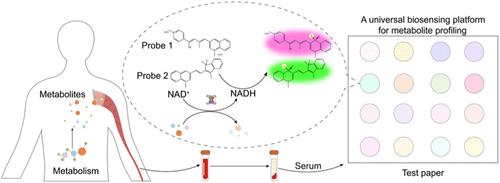基于动态分化二元生物传感平台的生物流体代谢物分析
IF 6.7
1区 化学
Q1 CHEMISTRY, ANALYTICAL
引用次数: 0
摘要
生物流体代谢物与人体健康有着至关重要的联系,开发一种通用的代谢物监测方法对于疾病诊断和健康管理至关重要。在此,我们报告了一个动态分化的二元生物传感平台,该平台对NAD(P)H具有特异性反应,可以分析多种生物流体代谢物。动力学分化的二元生物传感平台包括具有快速反应动力学的菁衍生物染料和具有慢反应动力学的喹啉衍生物染料。与传统的单一NAD(P)H检测策略相比,二元生物传感平台的线性范围扩大了20倍。NAD(P)H是生命系统中普遍存在的辅助因子,代谢产物的产生通常涉及NAD(P)H的消耗或产生。因此,通过二元生物传感平台测量生化反应过程中NAD(P)H浓度的变化,可以很容易地定量生物流体代谢物。在本研究中,血清山梨醇、2-羟基丁酸(2HB)和α-酮戊二酸(AKG)均采用二元生物传感平台进行定量,准确度均在93%以上。动态分化二元生物传感平台可以扩展到分析任何可以直接或间接与NAD(P)H反应的分子。此外,我们利用二元生物传感平台构建了一种基于纸张的检测方法,测试纸在即时(POC)生物流体代谢物分析中显示出良好的前景。本研究提出了一种简单的策略,扩大了传统单一检测系统的校准范围,并进一步为疾病相关生物分子的高通量分析提供了一种通用范例,在疾病诊断和健康管理方面具有良好的前景。本文章由计算机程序翻译,如有差异,请以英文原文为准。

Profiling of Biofluid Metabolites with a Kinetically Differentiated Binary Biosensing Platform
Biofluid metabolites have a crucial linkage with the health of the human body, and developing a universal method for metabolite monitoring is imperative for disease diagnosis and health management. Herein, we report a kinetically differentiated binary biosensing platform that is specifically responsive to NAD(P)H for profiling diverse biofluid metabolites. The kinetically differentiated binary biosensing platform comprises a cyanine derivative dye with fast reaction kinetics and a quinolinium derivative dye with slow reaction kinetics. Compared to the traditional unitary strategy for NAD(P)H detection, the linear range of the binary biosensing platform is widened by up to 20 times. NAD(P)H are ubiquitous cofactors in living systems, and metabolite production generally involves the consumption or generation of NAD(P)H. Thus, biofluid metabolites can be easily quantified by measuring the variation of NAD(P)H concentration during biochemical reactions with the binary biosensing platform. In this study, serum sorbitol, 2-hydroxybutyric acid (2HB), and α-ketoglutarate (AKG) were all quantified by the binary biosensing platform with accuracies higher than 93%. The kinetically differentiated binary biosensing platform can be extended to the analysis of any molecule that can react directly or indirectly with NAD(P)H. In addition, we constructed a paper-based assay with the binary biosensing platform, and the test papers showed good promise in the point-of-care (POC) profiling of biofluid metabolites. This study proposes a simple strategy to expand the calibration range of traditional unitary detection systems and further provides a universal paradigm for high throughput profiling of disease-associated biomolecules, which offers good promise in disease diagnosis and health management.
求助全文
通过发布文献求助,成功后即可免费获取论文全文。
去求助
来源期刊

Analytical Chemistry
化学-分析化学
CiteScore
12.10
自引率
12.20%
发文量
1949
审稿时长
1.4 months
期刊介绍:
Analytical Chemistry, a peer-reviewed research journal, focuses on disseminating new and original knowledge across all branches of analytical chemistry. Fundamental articles may explore general principles of chemical measurement science and need not directly address existing or potential analytical methodology. They can be entirely theoretical or report experimental results. Contributions may cover various phases of analytical operations, including sampling, bioanalysis, electrochemistry, mass spectrometry, microscale and nanoscale systems, environmental analysis, separations, spectroscopy, chemical reactions and selectivity, instrumentation, imaging, surface analysis, and data processing. Papers discussing known analytical methods should present a significant, original application of the method, a notable improvement, or results on an important analyte.
 求助内容:
求助内容: 应助结果提醒方式:
应助结果提醒方式:


